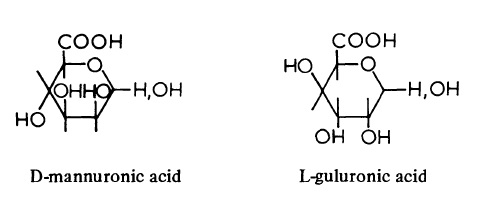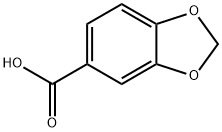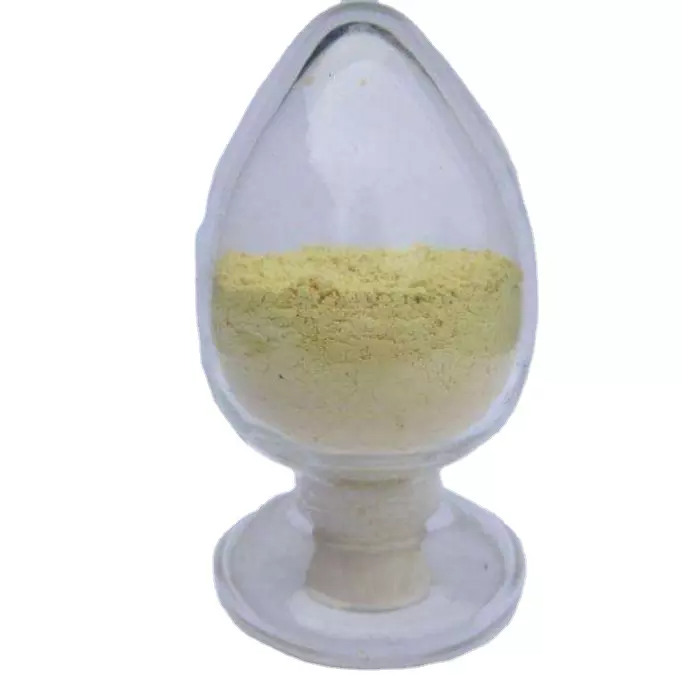Alginic acid
Synonym(s):Alginic acid from Macrocystis pyrifera (kelp);Mixed polymer of mannuronic and guluronic acid
- CAS NO.:9005-32-7
- Empirical Formula: (C6H8O6)n
- Molecular Weight: 0
- MDL number: MFCD00081309
- EINECS: 232-680-1
- SAFETY DATA SHEET (SDS)
- Update Date: 2025-01-27 09:38:02
What is Alginic acid?
Absorption
The absorption into the systemic circulation from oral formulations of alginic acid is reported to be minimal, as the mode of action of alginic acid is physical .
Toxicity
Probable oral lethal dose reported in humans is above 15 g/kg . Ingestion of large quantities may result in abdominal distension, intestinal obstruction, nausea, vomiting, and difficulty swallowing. Aspiration or inhalation may lead to pneumonitis . In the event of overdosage symptomatic treatment should be given .
Chemical properties
Alginic acid is a tasteless, practically odorless, white to yellowishwhite, fibrous powder.
Chemical properties
Alginic acid found in the walls of brown seaweeds (Phaeophyceae) consists of D-mannuronic acid units and L-guluronic acid units probably linked β (1->4). The chains contain three distinct regions; in one, the D-mannuronic acid units alternate with L-guluronic acid units, whereas the remaining regions are homogeneous and contain either D-mannuronic acid or L-guluronic acid. The lengths and proportions of the three regions vary with the seaweed species and are responsible for the differences in chemical and physical properties of the various alginates.
Alginic acid is biosynthesised from GDP-D-mannuronic acid and GDP-guluronic acid. It seems probable that guluronic acid is derived from its isomer, mannuronic acid, the re action being catalysed by an epimerase.

Monovalent salts of alginic acid are soluble in water, but polyvalent salts are either insoluble or form gels. Solutions of alginates are very viscous due to the high molecular weight and random-coil formation of the polymers. The jellying and thickening properties of alginates are widely used commercially in foodstuffs, etc.
The Uses of Alginic acid
algin (alginic acid) is used in cosmetic formulations as a thickener, stabilizer, and gelling agent. It is obtained from different varieties of brown seaweed.
The Uses of Alginic acid
corrosive moisture sensitive
The Uses of Alginic acid
Alginic Acid is the acidic, insoluble form of algin that is a white to yellowish fibrous powder obtained from brown seaweed genera, such as macrocystis pyrifera. the derivatives are soluble and include sodium, potassium, and ammonium alginate and propylene glycol alginate. it is used as a tablet disintegrant and as an antacid ingredient.
The Uses of Alginic acid
Gum derived from alginic acid which is obtained from brown seaweed genera, such as Macrocystis pyrifera. The derivatives are sodium, ammonium, and potassium ates of which the sodium salt is most common. They are used to provide thickening, gelling, and binding. A derivative designed for improved acid and calcium stability is propylene glycol ate. The s are soluble in cold water and form nonthermoreversible gels in reaction with calcium ions and under acidic conditions. Algin is used in ice cream, icings, puddings, dessert gels, and fabricated fruit.
Background
Alginic acid, also referred to as algin or alginate, is a hydrophilic or anionic polysaccharide isolated from certain brown seaweed (Phacophycae) via alkaline extraction. It is present in cell walls of brown algae where it forms a viscous gel when binding with water. Alginic acid is a linear polymer consisted of L-glucuronic acid and D-mannuronic acid residues connected via 1,4-glycosidic linkages . Available in different types of salt, alginic acid has been used in a variety of uses in food, cosmetics and pharmaceu-tical products for over 100 years . Alginic acid is an FDA-approved food ingredient in soup and soup mixes as an emulsifier, thickener, and stabilizer . It is also available in oral dietary supplements and is found in antacids such as Gaviscon to inhibit gastroesophageal reflux by creating a physical barrier in presence of gastric acid . Alginate-based raft-forming formulations in the management of heartburn and gastric acid reflux have been used worldwide for over 30 years .
Indications
Indicated for the management of gastric reflux, reflux oesophagitis, hiatus hernia, heartburn (including heartburn of pregnancy) and similar gastric distress .
Definition
A polysaccharide composed of β,d-mannuronic acid residues linked so that the carboxyl group of each unit is free, while the aldehyde group is shielded by a glycosidic linkage. It is a linear polymer of the mannuronic acid in the pyranose ring form.
Production Methods
Alginic acid is a hydrophilic colloid carbohydrate that occurs naturally in the cell walls and intercellular spaces of various species of brown seaweed (Phaeophyceae). The seaweed occurs widely throughout the world and is harvested, crushed, and treated with dilute alkali to extract the alginic acid.
Definition
A yellow-white organic solid that is found in brown algae. It is a complex polysaccharide and produces, in even very dilute solutions, a viscous liquid. Alginic acid has various uses, especially in the food industry as a stabilizer and texture agent.
Pharmaceutical Applications
Alginic acid is used in a variety of oral and topical pharmaceutical
formulations. In tablet and capsule formulations, alginic acid is used
as both a binder and disintegrating agent at concentrations of 1–5%
w/w. Alginic acid is widely used as a thickening and suspending
agent in a variety of pastes, creams, and gels; and as a stabilizing
agent for oil-in-water emulsions.
Alginic acid has been used to improve the stability of
levosimendan.
Therapeutically, alginic acid has been used as an antacid.In
combination with an H2-receptor antagonist, it has also been
utilized for the management of gastroesophageal reflux.
Pharmacokinetics
Alginic acid reduces reflux via its floating, foaming, and viscous properties . Alginic acid precipitates upon contact with gastric acid to create a mechanical barrier, or a "raft", that displaces the postprandial acid pocket . The formation of a raft is thought to occur rapidly, often within a few seconds of dosing . In clinical trials, alginic acid was effective in reducing the symptoms of gastroesophageal reflux disease (GERD) . In healthy volunteers, alginic acid in combination with an antacid was effective in decreasing postprandial reflux in the upright position . Alginic acid is able to bind to cations when ingested .
Safety Profile
Moderately toxic by intraperitoneal route. When heated to decomposition it emits acrid smoke and irritating fumes
Safety
Alginic acid is widely used in food products and topical and oral
pharmaceutical formulations. It is generally regarded as a nontoxic
and nonirritant material, although excessive oral consumption may
be harmful. Inhalation of alginate dust may be an irritant and has
been associated with industrially related asthma in workers
involved in alginate production. However, it appears that the cases
of asthma were linked to exposure to unprocessed seaweed dust
rather than pure alginate dust. An acceptable daily intake of
alginic acid and its ammonium, calcium, potassium, and sodium
salts was not set by the WHO because the quantities used, and the
background levels in food, did not represent a hazard to health.
LD50 (rat, IP): 1.6 g/kg
Metabolism
This pharmacokinetic parameter is unlikely to apply for alginic acid.
storage
Alginic acid hydrolyzes slowly at warm temperatures producing a
material with a lower molecular weight and lower dispersion
viscosity.
Alginic acid dispersions are susceptible to microbial spoilage on
storage, which may result in some depolymerization and hence a
decrease in viscosity. Dispersions should therefore be preserved with
an antimicrobial preservative such as benzoic acid; potassium
sorbate; sodium benzoate; sorbic acid; or paraben. Concentrations
of 0.1–0.2% are usually used.
Alginic acid dispersions may be sterilized by autoclaving or
filtration through a 0.22 μm filter. Autoclaving may result in a
decrease in viscosity which can vary depending upon the nature of
any other substances present.
Alginic acid should be stored in a well-closed container in a cool,
dry place.
Purification Methods
To 5g of acid in 550mL water containing 2.8g KHCO3 are added 0.3mL of acetic acid and 5g potassium acetate. EtOH is added to make the solution to 25% (v/v) in EtOH, and any insoluble material is discarded. Further addition of EtOH, to 37% (v/v), precipitated alginic acid. Collect the acid and dry it in vacuo. [Pal & Schubert J Am Chem Soc 84 4384 1962.]
Incompatibilities
Incompatible with strong oxidizing agents; alginic acid forms insoluble salts in the presence of alkaline earth metals and group III metals with the exception of magnesium.
Regulatory Status
GRAS listed. Accepted in Europe for use as a food additive. Included in the FDA Inactive Ingredients Database (ophthalmic preparations, oral capsules, and tablets). Included in the Canadian List of Acceptable Non-medicinal Ingredients. Included in nonparenteral medicines licensed in the UK.
Properties of Alginic acid
| Melting point: | 300 °C |
| storage temp. | Room Temperature |
| solubility | H2O: insoluble, but swells |
| form | Powder |
| color | White to pale yellow to beige |
| Odor | wh. to yel. fibrous powd., odorless, tasteless |
| Water Solubility | Insoluble in water. |
| Sensitive | Hygroscopic |
| Merck | 14,242 |
| CAS DataBase Reference | 9005-32-7 |
| EPA Substance Registry System | Alginic acid (9005-32-7) |
Safety information for Alginic acid
Computed Descriptors for Alginic acid
Alginic acid manufacturer
New Products
3-Iodophenylacetic acid 3-Pyridineacetonitrile, α-hydroxy- 2-Propanamine, 1-chloro-, hydrochloride (9CI) 3-(hexyloxy)-4-(pyridin-3-yl)-1,2,5-thiadiazole 2-Hexyn-1-ol Dibenzo-18-crown-6 Nickel(II) perchlorate hexahydrate, 98% 4-Bromophenylacetonitrile, 95% 3-Bromo-4-fluoroaniline, 97% Sodium tetraborate decahydrate, 98% Palladium(II) acetate, trimer, Pd 99% 4-Bromo-2-chlorotoluene, 97% N N Dimethylformamide Dimethyl Acetal (Dmf Dma) 2,3-Dichloro Benzoyl Cyanide [Side Chain] Bis(2-Chloroethyl) Amine Hydrochloride L-Glutamic Acid Diethyl Ester Hydrochloride 5-(Difluoromethoxy)-2-Mercaptobenzimidazole 1-Ethyl-3-(3-Dimethylaminopropyl)-Carbodiimide Hydrochloride [EDC Hcl] 1,4-Napthoquinone Bromoiodomethane Sodium Bicarbonate Methylene Dichloride (MDC) Ethyl Acetate Indole-3-Carbinol (I3C)Related products of tetrahydrofuran








You may like
-
 9005-32-7 Alginic acid 98%View Details
9005-32-7 Alginic acid 98%View Details
9005-32-7 -
 9005-32-7 98%View Details
9005-32-7 98%View Details
9005-32-7 -
 Alginic Acid ex. Brown Algae CAS 9005-32-7View Details
Alginic Acid ex. Brown Algae CAS 9005-32-7View Details
9005-32-7 -
 Alginic acid CAS 9005-32-7View Details
Alginic acid CAS 9005-32-7View Details
9005-32-7 -
 Alginic acid CAS 9005-32-7View Details
Alginic acid CAS 9005-32-7View Details
9005-32-7 -
 Alginic Acid CAS 9005-32-7View Details
Alginic Acid CAS 9005-32-7View Details
9005-32-7 -
 ALGINIC ACID Extra Pure CAS 9005-32-7View Details
ALGINIC ACID Extra Pure CAS 9005-32-7View Details
9005-32-7 -
 Alginic acid from brown algae CAS 9005-32-7View Details
Alginic acid from brown algae CAS 9005-32-7View Details
9005-32-7
